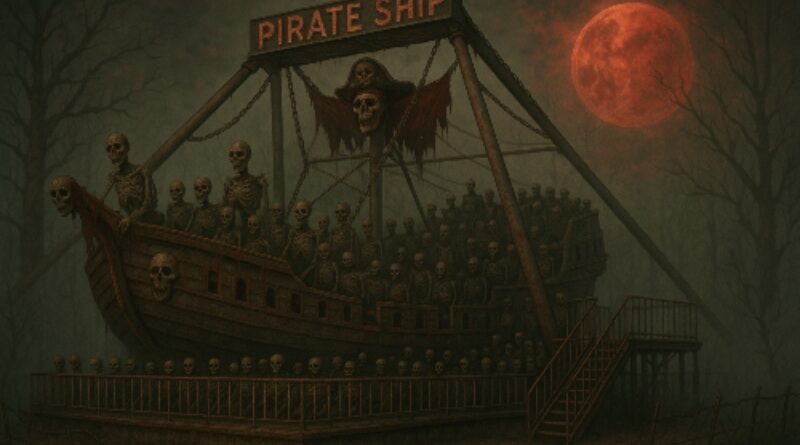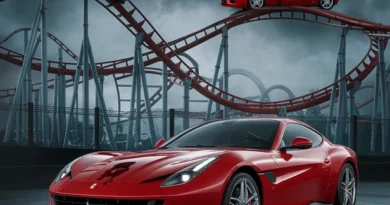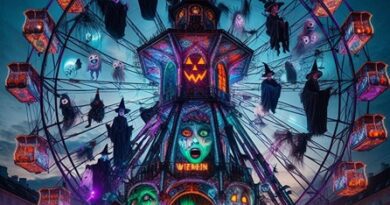Big Ship of Horrors: Everything You Need to Know About the Pirate Ship Ride
If you’ve ever seen a pirate movie – say “Pirates of the Caribbean” – you may have been sickened by watching the inevitable scenes in which the ship rocks like a drunk during a storm on stormy waves, with the sails filling with wind and lifting the vessel to terrifying heights, to the point of capsizing and sinking. This well-worn idea is the basis for one of the most popular rides in theme parks, the pirate ship. The ride attempts to convey the sensations of such a voyage to the world of amusement parks, and it is scary, exciting, but also potentially nauseating (depending on age and other parameters).
As a child, I remember standing in line at an amusement park, watching anxiously as people went up or fell over, and listening to the screams, all while imagining myself riding the attraction. As I grew up, I tried the ride several times, and I remember it as a scary experience since I am a little afraid of heights and don’t love being upside down. At the moment, as a father of two daughters and accompanying them to a large part of the rides, I don’t even try the ride because, fortunately, it’s not appropriate for their age, and mainly because at this stage of my life, the ship would probably make me nauseous for months.
Nevertheless, we decided to present to you everything you need to know about pirate ships, as part of our articles about scary rides. You will learn how exactly they work, what’s scary about them, and how you can find them (hint: not just in huge amusement parks).
When Was The First Pirate Ship Ride Made?
Pirate ships have accompanied humanity for several centuries, with the “golden age” of pirates beginning in the 16th century (from 1650), divided into three main periods.
The history of amusement rides is relatively short, with the common belief being that the first ship was developed by a man named Charles Albert Marshall in Tulsa, Oklahoma, between 1893 and 1897. Initially, he tested the ride with his relatives and family members, first calling it “The Ocean Wave”; later, it reached a wider audience through the Marshall Bros. Circus, which the family ran.
How Does The Pirate Ship Ride Work?
On the surface, “translating” this oceanic experience into a land-based facility seems like an obvious step, because a pirate ship has all the potential to be remarkably scary. The facility consists of a large boat (or other shape) connected to a mechanical arm, which swings in a rhythmic pendulum motion thanks to a powerful electric motor. Various physical explanations are available on the web, including AI solutions, such as G-forces, weightlessness, or heavy pressure, which, of course, contribute to the experience of instability and fear. However, I don’t really understand a damn thing about such terms, so we’re gonna leave it this way for now.
The main principle is that users of the facility sit in rows and, of course, fasten their belts tightly. The ship moves forward and backward, or up and down, in a circular motion and at high speed. Typically, the movement is gradual, meaning it begins at relatively low heights and gradually reaches heights of tens of meters. In practical terms, the ship creates quarter circles and half circles, and in the scarier versions, it also performs a complete inversion in the air.
To enhance the experience and simulate sailing on a pirate ship as closely as possible, the design can incorporate elements such as sails, masts, a skull and crossbones flag (the traditional symbol of pirates), cannons, and other similar features. There are many types of boats, such as Viking ships or small ones, called “Swingboats”. Some Pirate Ship rides feature sound effects that blend in perfectly with the screams of the people boarding the attraction, adding to the atmosphere.

Who Can Ride A Pirate Ship?
Age, especially height, plays a significant role in defining the target audience for pirate ships. Beyond the standard requirements, boarding the vessel is usually only permitted from a height of 140-150 cm on the scarier ships, or approximately 100 cm on those relevant to children.
Although there is no maximum age for a pirate ship, the facility is less recommended for people who suffer from a fear of heights, sensitive populations, pregnant women, and the like. It is recommended that people who are sensitive to nausea (and at a certain age, almost every man or woman becomes so) avoid the facility, or at least eat in the hours before boarding it.
In order not to put visitors to the amusement park in a scene from a “Final Destination” movie, pirate ship rides have stringent safety systems, which can include double safety harnesses with automatic locking, safety rails, bars (especially if the ship makes a complete turn), emergency braking systems, and so on. The responsibility of park managers is to monitor the facility’s components around the clock, and, of course, place qualified employees next to them to operate it – and yes, this involves more than just pressing a button.
Different Types Of Pirate Ship Rides
It is essential to note that there are several types of pirate ships, each with its unique characteristics and levels of fear. A classic pirate ship will move on one axis and perform oscillations, back and forth, at angles that can exceed 90 degrees. As mentioned, some ships perform several inversions (loops) in the air, usually after a few less extreme ups and downs. Kamikaze, for example, is based on two ships that are placed next to each other, with their movement in opposite directions.
For younger ages, there are smaller and milder versions of the ride. These ships swing at smaller angles and slower speeds, and rise to a height of several meters. They are usually designed in a more colorful and child-friendly way and are not supposed to be scary. However, the writer of these lines remembers suffering from very mild nausea even after riding such a device.
The safety systems include double safety harnesses with automatic locking, high safety rails, and emergency braking systems. Before each operation, all components of the device are checked, including the screws, chains, and motors.
The safety regulations also include restrictions on the health status of the passengers – people suffering from heart problems, high blood pressure, back or neck problems, pregnant women, or people under the influence of alcohol or drugs are not allowed to ride the device, or at least advised not to go up.
Pirate Ships Go All Directions
Of course, this is too short a list to list all the pirate ships in theme parks around the world, which reach impressive heights of fear. Almost every self-respecting theme park has at least one pirate ship, sometimes with a twist. And by the way, if you’ve also heard that the “Pirates of the Caribbean” movies are based on a ride of the same name in Walt Disney’s theme parks, that’s true. Just note that, contrary to its name, this ride is a dark ride, and not a pirate ship like the ones we’re featuring in this article.
You don’t have to go to an amusement park to ride a pirate ship. In many cases, you can easily find different types of inflatable pirate ships, even if most of them are facilities with slides, swings, climbing walls, and the like, and less of a mechanical boat that moves back and forth like we know from the big parks. Despite this, we did find some miniature pirate ship rides that resemble the “real thing”.
Pirate ships can, of course, be a tourist attraction. There are various destinations where you can go on a pirate ship cruise. However, fortunately, it is usually a ship designed as a pirate ship with multiple attractions for children (say, workshops, shows, or slides and inflatables into the water), and fewer ships that simulate the scary voyage in a stormy sea – I mean, we hope they offer a calm ride. The Ayia Napa Pirate Ship, for example, is one of the island’s most worthwhile attractions, certainly for families with children: It’s a 4-hour cruise on the “Black Pearl” ship, which will take you on a cruise between some of the island’s spectacular sites (such as the Sea Caves, Konos Bay, Fig Tree Bay and Cape Greco), with an emphasis on the Ayia Napa and Protaras areas. The twist is that the cruise includes live shows, pirate battles, treasure hunt games, and, of course, stops for diving and swimming.
In the consumer world, you will find a wide variety of products in the design of a pirate ship, and sometimes also in a way that simulates its movement on a stormy sea:
🏴☠️ A pirate ship to assemble, including a Lego of pirate ship or various versions of a Playmobil pirate ship. Some models feature highly accurate ships with movement mechanisms that attempt to replicate the real thing.
🏴☠️ Tabletop versions of the pirate ship installation, sometimes with matching figures.
🏴☠️ Pirate ship-themed decorations and statues.
🏴☠️ 2D and 3D pirate ship puzzles.
🏴☠️ Pirate ship piñata, which can be a nice activity for birthdays, bachelor or bachelorette parties, and so on
🏴☠️ “Pirate” style fashion items, sometimes with a print of a ship or elements related to it (say, an anchor or skulls)
🏴☠️ Pirate costumes, which may seem out of context. Still, the costumes blended well with the attractions.
💀 Killer Deals & Scary Recommendations 💀
🎭 Costumes & Accessories
HalloweenCostumes Fun Costumes Entertainment Earth
🛒 Online Shopping
AliExpress Amazon Walmart Etsy
🧛 Collectibles & Horror Brands
Funko Hot Topic Lego Spirit Halloween
🎢 Attractions & Tours
GetYourGuide Tiqets Viator Klook
📖 Blogs & Horror Sites
Bloody Disgusting iHorror Fangoria
🩸 Disclaimer: Some links are affiliate links. The price stays the same – it just helps keep the site alive 👻





